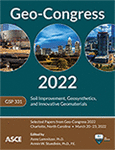Investigating the Dissolution Behavior of Calcium Carbonate Bio-Cemented Sands
Publication: Geo-Congress 2022
ABSTRACT
Microbially Induced Calcite Precipitation (MICP) is a bio-mediated cementation process that uses microbial enzymatic activity to catalyze the precipitation of CaCO3 minerals on soil particle surfaces and contacts. Extensive research has focused on understanding various aspects of MICP-treated soils including soil behavioral enhancements and process reaction chemistry, however, almost no research has explored the permanence of bio-cemented geomaterials. As the technology matures, an improved understanding of the longevity of bio-cementation improved soils will be critical towards identifying favorable field applications, quantifying environmental impacts, and understanding their long-term performance. In this study, a series of batch experiments were performed to investigate the dissolution kinetics of CaCO3-based bio-cemented sands with the specific aim of incorporating these behaviors into geochemical models. All batch experiments involved previously bio-cemented poorly graded sands that were exposed to different dissolution treatments intended to explore the magnitude and rate of CaCO3 dissolution as a function of acid type, concentration, initial pH, and other factors. During experiments, changes in solution pH and calcium concentrations indicative of CaCO3 dissolution were monitored. After experiments, aqueous measurements were compared to those simulated using two different dissolution kinetic frameworks. While not exhaustive, the results of these experiments suggest that the dissolution behavior of bio-cementation can be well-approximated using existing chemically controlled kinetic models, particularly when surrounding solutions are more strongly buffered.
Get full access to this article
View all available purchase options and get full access to this chapter.
REFERENCES
ASTM. (2014). Standard test method for rapid determination of carbonate content of soils. ASTM D4373-14, West Conshohocken, PA.
Burdalski, R., and Gomez, M. G. (2020). “Investigating the Effects of Biogeochemical Conditions During Microbially Induced Calcite Precipitation (MICP) Soil Improvement”, Geo-Congress 2020: Biogeotechnics, ASCE, Reston, VA.
Colombani, J. (2016). “The alkaline dissolution rate of calcite.” The Journal of Physical Chemistry Letters, 7(13), 2376–2380.
Cubillas, P., Köhler, S., Prieto, M., Chaïrat, C., and Oelkers, E. H. (2005). “Experimental determination of the dissolution rates of calcite, aragonite, and bivalves.” Chemical Geology, 216(1-2), 59–77.
Gehlen, M., Bassinot, F. C., Chou, L., and McCorkle, D. (2005). “Reassessing the dissolution of marine carbonates: II. Reaction kinetics.” Deep Sea Research Part I: Oceanographic Research Papers, 52(8), 1461–1476.
Gomez, M. G., and DeJong, J. T. (2017). “Engineering properties of bio-cementation improved sandy soils.” Grouting 2017, 23–33. ASCE, Reston, VA.
Gomez, M. G., Graddy, C. M., DeJong, J. T., and Nelson, D. C. (2019). “Biogeochemical changes during bio-cementation mediated by stimulated and augmented ureolytic microorganisms.” Scientific Reports, 9(1), 1–15.
Lee, M., Kolbus, C. M., Yepez, A. D., and Gomez, M. G. (2019). “Investigating Ammonium By-Product Removal following Stimulated Ureolytic Microbially-Induced Calcite Precipitation.” Geo-Congress 2019: Soil Improvement, ASCE, Reston, VA, 260–272.
Martinez, B. C., and DeJong, J. T. (2009). “Bio-mediated soil improvement: load transfer mechanisms at the micro-and macro-scales.” Advances in ground improvement: research to practice in the United States and China, ASCE, Reston, VA. 242–251.
Minto, J. M., MacLachlan, E., El Mountassir, G., and Lunn, R. J. (2016). “Rock fracture grouting with microbially induced carbonate precipitation.” Water Resources Research, 52(11), 8827–8844.
Montoya, B. M., and DeJong, J. T. (2015). “Stress-strain behavior of sands cemented by microbially induced calcite precipitation.” Journal of Geotechnical and Geoenvironmental Engineering, 141(6), 04015019.
Morse, J. W., and Berner, R. A. (1972). “Dissolution kinetics of calcium carbonate in sea water; I, A kinetic origin for the lysocline.” American Journal of Science, 272(9), 840–851.
Morse, J. W., and Arvidson, R. S. (2002). “The dissolution kinetics of major sedimentary carbonate minerals.” Earth-Science Reviews, 58(1-2), 51–84.
Sjöberg, E. L. (1978). Kinetics and mechanism of calcite dissolution in aqueous solutions at low temperatures. Stockholm Contrib. Geol., 32, 92 pp.
Sjöberg, E. L., and Rickard, D. (1983). “The influence of experimental design on the rate of calcite dissolution.” Geochimica et cosmochimica acta, 47(12), 2281–2285.
Stocks-Fischer, S., Galinat, J. K., and Bang, S. S. (1999). “Microbiological precipitation of CaCO3.” Soil Biology and Biochemistry, 31(11), 1563–1571.
Stumm, W., and Morgan, J. J. (2012). Aquatic chemistry: chemical equilibria and rates in natural waters. John Wiley & Sons.
Parkhurst, D. L., and Appelo, C. A. J. (2013). Description of input and examples for PHREEQC version 3: a computer program for speciation, batch-reaction, one-dimensional transport, and inverse geochemical calculations (No. 6-A43). US Geological Survey.
Information & Authors
Information
Published In
History
Published online: Mar 17, 2022
Authors
Metrics & Citations
Metrics
Citations
Download citation
If you have the appropriate software installed, you can download article citation data to the citation manager of your choice. Simply select your manager software from the list below and click Download.
